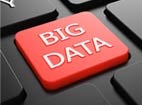If you are a senior data analytics professional working in the heath care sector, what does the Ebola situation mean to you? To one such professional, it means the potential for an all-hands-on deck response that would break down data-sharing barriers and shift the data-analytics focus from “blocking and tackling” to true innovation.
That professional is Mike Berger, vice president of enterprise analytics at Geisinger Health System, a hospital system in Danville, Pa. I had the opportunity to speak with Berger last week at the Teradata 2014 Partners conference in Nashville, and I brought up the Ebola question almost as an afterthought. If Ebola became a major problem in the United States, I asked him, how might that affect his life? How might data analytics be tapped to deal with the problem?
“The clinical leadership would push us to break down the barriers that keep us from sharing data from one provider to another, which Obamacare was trying to do, but at a very slow pace,” Berger said. “I think the world would turn on its side, and we would be asked to instantly try to interconnect our data storage with other groups’ data storage, and someplace would become the place where the mining would happen, and that would probably be us, in our geographic region. It would be a horrific experience, but the value we would get from an analytics perspective in breaking down these barriers, really would be tremendous.”
Berger explained that currently, “there’s a lot of blocking and tackling, and not a lot of innovating” in data analytics, due to the financial constraints that hospital systems face. An emergency situation like an Ebola outbreak would give hospital systems the green light for quality and process improvement.
“Something like this would align innovation, analytics, and the quality of patient care and safety, all at the same time,” he said. “So emergencies like this could actually create quick pops of innovation, where we create better interoperability and better integration, because we see it as an emergency problem that needs to be fixed.”
Berger went on to explain that if someone with Ebola became a patient at his hospital, the clinical leadership would want to immediately know more not just about the patient, but about all the patients and employees around the patient.
“That stuff is in the medical records, but it’s not linked together — no one ever has done that,” Berger said. “Even though infectious diseases are always a problem, there’s never been a big enough burning platform from an analytics perspective for them to ask us, ‘I need to know all the people in the environment of the patient.’ Historically, it’s been, ‘Just tell me about the patient.’ I think an infectious disease like this would instantly build that burning platform. It would be fantastic to get the resources and the empowerment to make it happen.”
Of course, the price would be extraordinarily high.
“Obviously, it would be a horrible emergency,” Berger said. “I’m sure there would have been lives lost, and mass hysteria.”
Berger noted that Geisinger is an early adopter of revised Ebola-related protocols in electronic medical records, or EMRs. He said that happened within a couple of days of the Ebola issue surfacing.
“The platform supports that — they can put in best-practice alerts,” Berger said. “Essentially, it nudges the clinician to ask these extra questions that weren’t part of the normal protocol. Answers to those questions would kick off other protocols, which are largely manual. But there’s a front-end protocol that’s been built right into the EMR that helps us document that we went through the protocol correctly. That’s a big portion of what EMRs do — they’re there to document that somebody did something. Whether it was effective or not is irrelevant.”
Berger said that from an analytics perspective, the Ebola issue is both a micro problem and a macro problem. On a micro level, it’s dealing with a single patient, and getting critical information from the medical record. On a macro level, it’s dealing with populations.
“It’s understanding what the risk is, and what the value is of the different options to try to mitigate that risk,” he said. “If it became a huge problem, it would be all hands on deck, and I think smart people would come up with really creative solutions very quickly.”
A contributing writer on IT management and career topics with IT Business Edge since 2009, Don Tennant began his technology journalism career in 1990 in Hong Kong, where he served as editor of the Hong Kong edition of Computerworld. After returning to the U.S. in 2000, he became Editor in Chief of the U.S. edition of Computerworld, and later assumed the editorial directorship of Computerworld and InfoWorld. Don was presented with the 2007 Timothy White Award for Editorial Integrity by American Business Media, and he is a recipient of the Jesse H. Neal National Business Journalism Award for editorial excellence in news coverage. Follow him on Twitter @dontennant.




